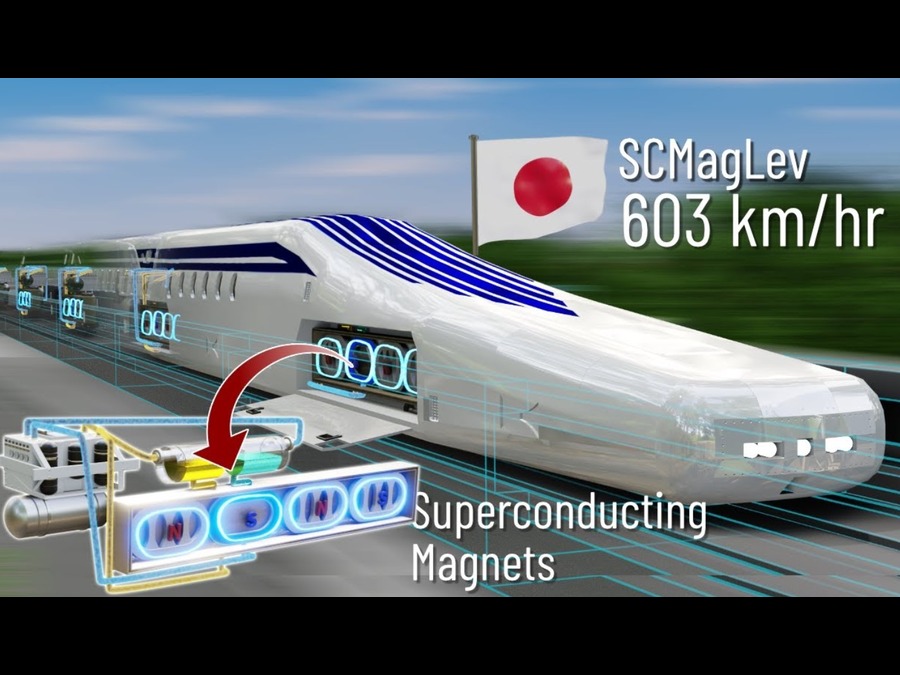Superconductor Magnetic Levitation Train
Superconductor in Transportations
Superconductors hold significant promise for transportation applications due to their unique properties, particularly their ability to conduct electricity without resistance when cooled below a critical temperature.
Maglev Trains: Superconductors are fundamental to magnetic levitation (maglev) train technology. Superconducting magnets installed along the track generate powerful magnetic fields that repel magnets on the train, allowing it to levitate and move without friction. This enables maglev trains to achieve high speeds and energy efficiency.
Electric Motors and Propulsion Systems: Superconducting materials can be used in electric motors and propulsion systems for various transportation modes, including ships, aircraft, and electric vehicles. Superconducting coils in motors can generate stronger magnetic fields, leading to more efficient propulsion systems and reduced energy consumption.
Magnetic Energy Storage: Superconductors can be used in magnetic energy storage systems for transportation applications. These systems store energy in the form of a magnetic field, which can then be converted back to electrical energy when needed. They have the potential to improve the efficiency of regenerative braking systems in electric vehicles and trains.
High-Efficiency Cables and Conductors: Superconducting wires and cables have very low electrical resistance, allowing for the efficient transmission of electricity over long distances.
Electromagnetic Launch Systems: Superconductors are being explored for use in electromagnetic launch systems, such as electromagnetic aircraft launch systems (EMALS) for aircraft carriers and electromagnetic rail guns for naval applications
Magnetic Levitation Train:
A magnetic levitation (maglev) train is an advanced form of transportation that utilizes powerful magnetic fields to levitate and propel the train above its tracks without physical contact. This technology offers several advantages over traditional rail systems, including higher speeds, smoother rides, and reduced maintenance costs. Here’s a brief introduction to magnetic levitation trains:
- Principle of Magnetic Levitation:
Maglev trains employ the principle of magnetic repulsion to levitate above the tracks. Superconducting magnets installed on the train and along the guideway generate magnetic fields that repel each other, causing the train to float. The absence of physical contact between the train and the tracks eliminates friction, leading to smoother rides and reduced wear and tear on the infrastructure.
- Propulsion System:
In addition to levitation, maglev trains use magnetic propulsion to move forward. Linear induction motors or linear synchronous motors along the guide way generate alternating magnetic fields that push and pull the train forward. This propulsion system enables maglev trains to accelerate quickly and reach high speeds, making them suitable for long-distance travel and high-speed rail corridors.
- Challenges and Considerations:
Cost: The initial construction costs of maglev infrastructure can be high compared to conventional rail systems, primarily due to the need for specialized guideways and propulsion technology.
Limited Deployment: Despite their advantages, maglev trains are not yet widely deployed globally. Implementation requires significant investment and political will, and many regions continue to rely on conventional rail systems.
Technological Development: Ongoing research and development efforts are focused on improving maglev technology, including increasing energy efficiency, reducing construction costs, and addressing safety concerns.
Magnetic Levitation Train in India
As of my last update in January 2022, India does not have operational magnetic levitation (maglev) train systems. While there have been discussions and proposals for introducing maglev technology in India, no such system has been implemented on a large scale. However, India has been exploring various high-speed rail projects, including the Mumbai–Ahmedabad High-Speed Rail Corridor, which is being developed with Japanese Shinkansen technology (bullet train). This project aims to connect Mumbai and Ahmedabad with high-speed rail service.
While maglev technology has the potential to revolutionize rail transportation with its high speeds and smooth operation, it requires significant investment in infrastructure and development. The decision to implement maglev trains depends on various factors such as feasibility, cost-effectiveness, and alignment with the country’s transportation goals.Given India’s focus on expanding and modernizing its rail infrastructure, it’s possible that maglev technology may be considered in the future, especially as technology advances and transportation needs evolve. However, as of my last update, there are no operational maglev trains in India.
Advantage Of Magnetic Levitation Train
High Speeds: Maglev trains can achieve extremely high speeds compared to traditional rail systems. With reduced friction and air resistance, maglev trains can reach speeds well beyond those of conventional trains, making them suitable for high-speed rail corridors.
Smooth and Comfortable Ride: The absence of wheels and physical contact between the train and the tracks eliminates friction and results in a smoother ride. Passengers experience less vibration and noise, contributing to a more comfortable and enjoyable travel experience.
Reduced Maintenance: Maglev trains experience less wear and tear on both the train and the tracks due to the lack of physical contact. This leads to lower maintenance costs and longer lifespans for the infrastructure, making maglev systems more cost-effective in the long run.
Efficient Energy Use: Maglev trains are more energy-efficient than traditional trains. The absence of friction allows for more efficient energy utilization, and regenerative braking systems capture and reuse energy during deceleration, further improving overall energy efficiency.
Quick Acceleration and Deceleration: The magnetic propulsion systems used in maglev trains enable rapid acceleration and deceleration. This feature contributes to reduced travel times and increased operational efficiency, especially in urban and intercity transit scenarios.
Minimal Environmental Impact: Maglev trains have lower greenhouse gas emissions compared to conventional trains powered by fossil fuels. The energy efficiency and reduced environmental impact make them a more sustainable option for mass transportation.
Reduced Noise Pollution: The lack of physical contact between the train and the tracks results in quieter operation. Maglev trains produce less noise compared to traditional trains, contributing to lower noise pollution along the train routes and in surrounding areas.
High Safety Standards: Maglev systems are equipped with advanced safety features, including automatic control systems and redundant fail-safe mechanisms.
Futuristic Image and Innovation: Maglev technology represents a cutting-edge and futuristic mode of transportation. The innovation associated with maglev trains can enhance the image of a city or region, attracting attention and investment.
Source:

